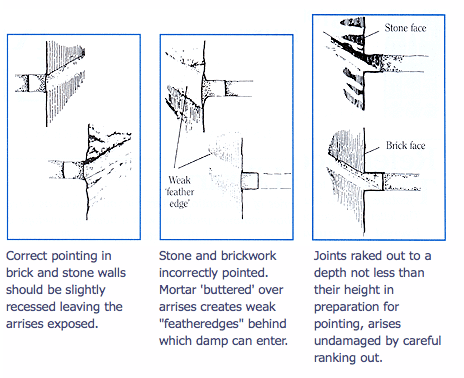REPOINTING consists of cutting out loose and disintegrated mortar to a depth of at least 1/2 inch or to the depth of disintegration, whichever is greater, and replacing it with new.
In a masonry wall (brick stone or block), the exposed face of the mortar joint is subject to gradual erosion due to rain, wind and wind- driven dust and grit. Frost attack also contributes to the breakdown of materials.
Once the exposed face of the mortar has receded behind the outer wall face, the arrises of the masonry become more vulnerable to erosion. At some point the joints become so worn that water can penetrate and saturate the wall. Holes can sometimes develop in the joints due to improper bedding of the masonry or other, specialized, localized influences.
In order to render a wall sound and solid, all voids should be filled and loose, cracked or disintegrated mortar joints repointed. The joints to be treated should be properly cut out so that enough material will be used to properly key in and hold. The backside and ends of the cut out joints should be squared off to avoid feather-edging of the material upon placement.
The mortar mix should be compatible with the existing masonry. It must be softer than the brick or stone units and be flexible enough to accommodate expansion, contraction and other forms of wall movement. The wall will breathe through the mortar joints if they are relatively soft and not over-tooled.
The mortar mix for most vintage/historic buildings should be a Portland cement slacked lime putty: sand mix coloured and shaped so as to match the adjacent existing as closely as possible. Modern mortars are typically too cement rich to even consider using. The mortar mix should be fairly dry to avoid shrinkage cracks. The wall is wetted down prior to repointing and kept from drying out too fast by shading and/or the use of damp burlap against the wall. Lime-rich mortars will turn to powder if they dry out too fast on a hot, sunny, day. They are also more sensitive to freezing, so greater care must be used. Deep repointing is done in layers (called “lifts”) to avoid shrinkage cracking and voids and ensure a good bond of the material.
Mortar additives are discouraged and mortar colours used only as required to attain a result pleasing to the eye when looking at a building wall. Generally the characteristics of the existing mortar should be repeated when repointing to ensure compatibility and aesthetic continuity.
Great care must be exercised in cutting out defective mortar joints. Saws held all day may “wander’ on the workers toward the end of a shift, causing damage. Hard, cement rich mortar is difficult to remove without damaging the masonry. Sometimes it is better left in place than risk doing damage to a wall. Most careful cutting out work is done by hand using hammer and sharp chisels.
Repointing is an essential aspect of building maintenance and can save the owner a great deal if scheduled as part of a strategic plan. If such work is improperly completed, the outcome can be far worse than if it had never been started. Be sure always to have qualified professionals skilled in vintage/heritage building restoration work perform the work.


No Comments